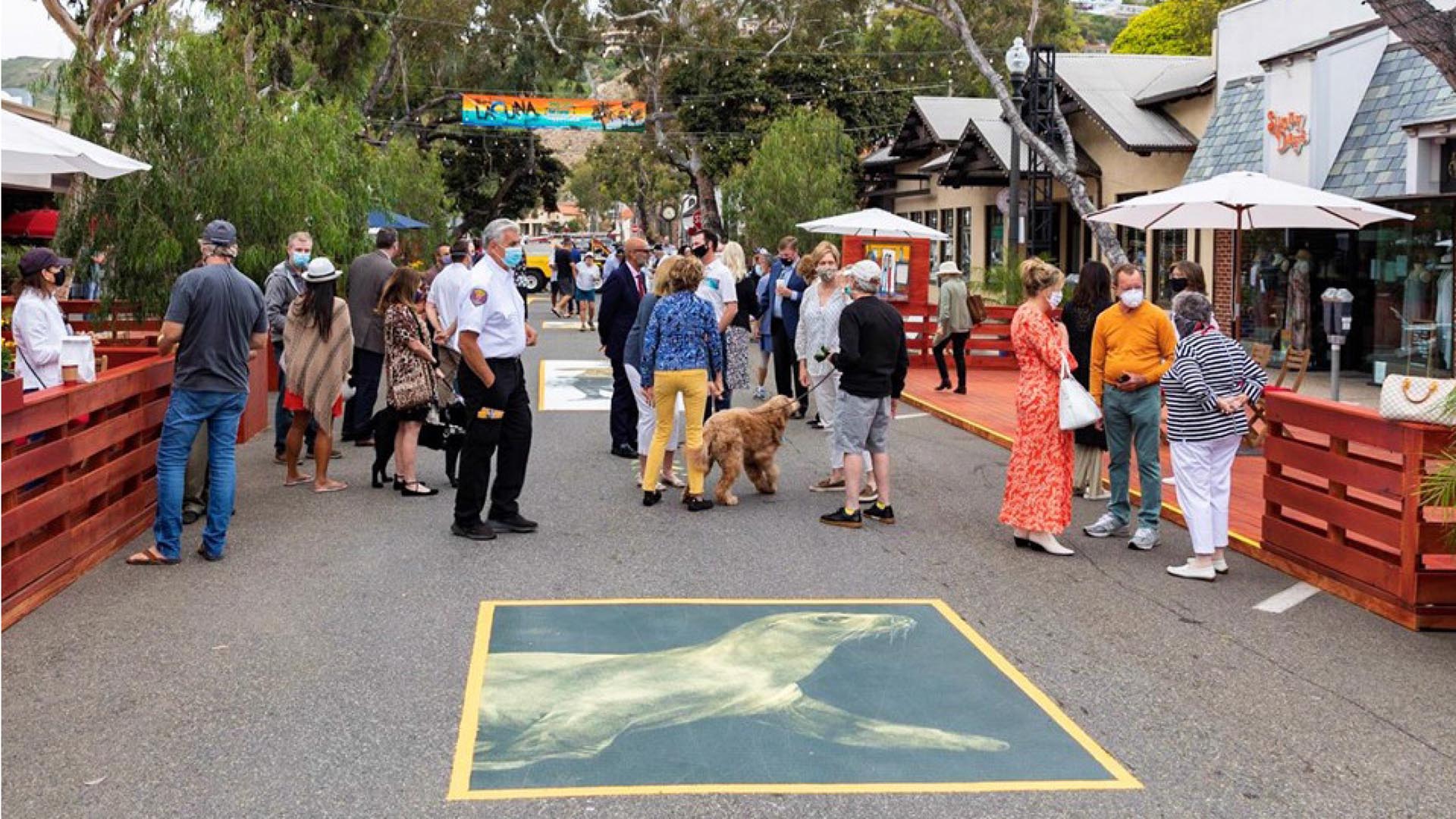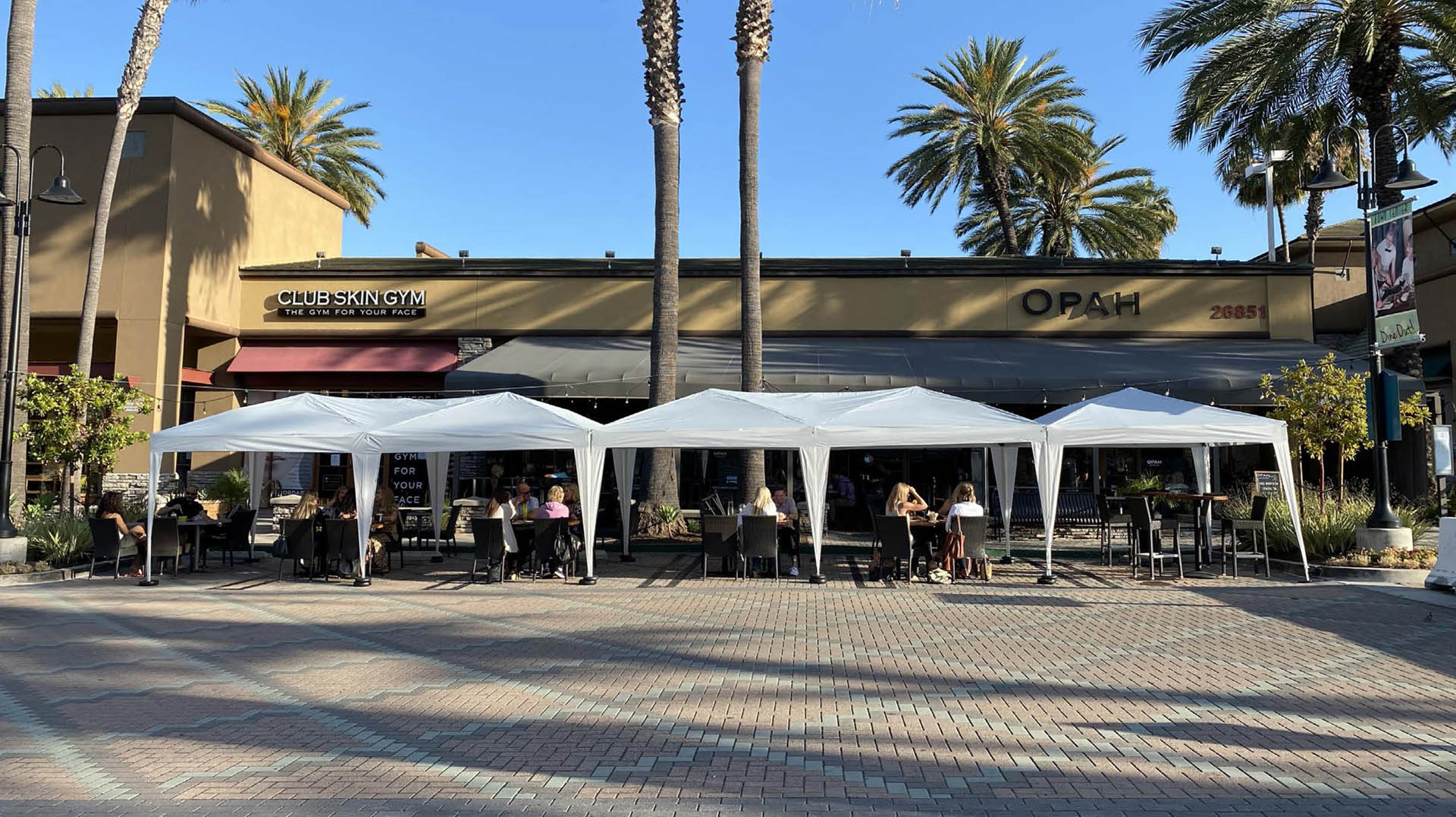10 Steps for Shared Streets:
Scalable Urban Solutions
As the world navigates a global pandemic, access to meaningful outdoor spaces has rarely been more important for physical and mental health – and for small businesses, strategies for safe, economical operations are in high demand. As cities navigate the “new normal” with COVID-19, SWA is helping communities in Laguna Beach and Aliso Viejo, California, as well as in Houston, Texas, to re-engage their economy safely by re-imagining the streets themselves with quick, inexpensive ways to celebrate the warm summer and early-fall months. Selected streets are being temporarily converted for pedestrian-only activities, and this newfound space allows for safe, physically distant outdoor dining and retail.
With one such intervention already in place, SWA’s practitioners have mapped out ten steps to help guide cities through conversions that could potentially prove to provide lasting value, post-pandemic.
Laguna Beach, California’s Promenade on Forest is an adaptable proof of concept for this “kit of parts.” The project’s success, since its opening in June 2020, has illuminated ten best practices for designers and cities exploring similar options, illustrated in the slideshow above.
While the steps outlined in the slide show offer a prototypical approach, they will manifest differently in different places.
For example, the new Promenade on Forest effort, a collaboration with the City of Laguna Beach, transforms the primary block of Laguna’s main street into a car-free zone with cafe seating, work from local artists, and retail display areas. Among the project’s primary aims is to support local businesses impacted by lost revenue associated with COVID-19. The design introduces seven large wooden decks, with rails made from pallets and painted in a mahogany tone, as well as movable tables and chairs that provide additional dining space while adhering to social distancing requirements. A significant grade change from the businesses to the street was a key consideration for the café and lounge furniture. “You don’t want people sliding off their seats, or food off the tables,” Principal-in-Charge Sean O’Malley points out.

The implementation of Laguna Beach’s Promenade on Forest reflects the city’s artistic culture, giving a new expression for street art.
Overhead string lights provide a warm ambience in the evenings until 10 p.m., attracting diverse diners, shoppers, and people-watchers. The space is enlivened by works by local artists, inviting Adirondack chairs, and boxed Australian willows; large umbrellas provide shade. The city has mandated that face masks be worn when patrons are not eating food, and pedestrians follow the defined one-way circulation pattern to maintain physical-distancing requirements.
Straddling the divide between “stay-at-home” and “open-up” proponents, Promenade on Forest serves as a model for public space that takes into consideration health, culture and the local economy. Public health and safety measures are made visible through directional sidewalk and street arrows for one-way pedestrian traffic, introduction of hand washing stations, additional retail signage in the street, and visible cleaning staff.

Conceptual sketches for Promenade on Forest illustrating, from left to right, before-and-after states, shaded outdoor seating, and bollards for pedestrian safety.
Critically, the concepts guiding the Promenade on Forest are applicable from modest beach towns to major metropolitan areas like Houston, Texas. “By looking at the intersection between the public and private realm – the street/sidewalk network – we find opportunities to serve the community as well as businesses that need to expand physical space to provide their services while supporting public health,” says Principal Kinder Baumgardner, who is heading up the Main Street HTX street redesign in Houston. Now in the visioning stage, the project re-imagines one of the city’s primary public transportation arteries, with the goal of bringing people into the heart of the Downtown district from cars, trails, and existing light rail.

Diagram and section study for Main Street HTX
Key elements of the plan include expanded seating adjacent to the storefronts and in well-lit areas, with controlled access; room for pedestrian movement through the expanded promenade, and space for digital (and eventually, live) performances. Furnishings and features will leverage color, lighting, and function to differentiate the site while remaining in character with the downtown context.
“In Downtown, the ability to expand physical spaces has historically been highly constrained and often impractical,” Baumgardner says. “By closing Main Street to vehicular traffic, we have the opportunity to essentially create a linear ‘plaza,’ with access to shopping, dining, and entertainment.” Programming for Main Street HTX will attract visitors during both day and night, and bring vibrancy to the district after the workday ends. Pop-up markets will bring others on weekends; the space is also anticipated to draw local artists to display outdoor installations.
Also proposed is Aliso Viejo’s Town Center’s proposed “Summer Remix” street closure and reinvention, a California site that shares many of the same goals as the Promenade on Forest and Main Street HTX: to create a safe, yet enticing pedestrian-only experience along Town Center Drive for the summer of 2020; to support local businesses by expanding customer seating and gathering areas into the street; and to integrate art, play, and specialty programming.

Current shaded outdoor dining along Town Center’s storefronts.
The “Summer Remix” Principal-in-Charge, Sean O’Malley, identified several key details in planning the temporary closure, which is currently being considered by the City of Aliso Viejo. Sharing Houston’s sunny climate, the Town Center closure necessitates shade structures for informal seating and misters for cooling. Flexibility is also critical. “Alternating anchor programs and events can provide diverse activation of the space, but that means that business owners and the City need to be able to move or modify furniture and other elements,” said O’Malley, cautioning that while picnic tables or heavier furnishings can remain overnight, moveable cafe seating may need to be locked down. He also sees potential for temporary planting or art installations to add interest from the street, including vertical banners on light poles. In keeping with COVID-19 best practices, Town Center will also include hand sanitizing stations.
With design that anticipates quick fabrication and installation, communities nationwide can take advantage of the mild climate of summer and early autumn to help local businesses re-open, stitching social, environmental and economic fabric together.


